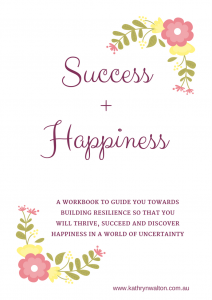
If you pick up a newspaper or magazine, read the news online, or scroll through social media, you’re sure to be confronted with the pros and cons of the eternal pursuit of happiness. It presents a bit like the fad diets that come and go, and it preys on the vulnerable – those of us who think we should / could / would be happier if only ….. And so much of it feels out of our own control.
The fact is that we live in a world of uncertainty, unpredictability and chaos. It’s been this way since the beginning of time and the world of nature continues to operate this way. In humankind’s attempts to bring order and control to the mess we perceive around us and in our internal world, we can be forgiven for expecting to reach utopian happiness once we’ve got everything sorted.
But the world isn’t that co-operative! The world as we know it can change at any time, and our intention to remain cool, calm and collected seemingly go out the window, leaving us feeling even more vulnerable and out of control. Unexpected changes come in many forms including sickness, injury, job loss, relationship upheavals and extreme weather.
Now this is all sounding terribly doom and gloom so far! How can one possibly connect with happiness if there isn’t really any hope of controlling the instability around us? This brings up the question “What is happiness?” and subsequently “Are we looking in the right place?”
Whilst I’m not going to delve any further into those philosophical questions here, I am going to suggest that whatever and wherever happiness is, there are two other critical elements we can focus on that will stand us in good steed when it comes to adapting to the world we live in: the skills to be RESILIENT, and the skills to THRIVE. The important thing to remember is that these are skills that all of us can learn and continue to develop throughout our lives.
Resilience is built upon a solid foundation of self-care. When we are resilient, we have the capacity to not only survive what life throws at us, but to thrive. To be able to flourish in an environment of uncertainty and unpredictability surely leads us towards success and happiness.
It can be very confusing trying to identify the ‘ingredients’ that go together to  make the best ‘recipe’ for resilience and happiness – our world is full of distractions and quick-fix ideas. So, here I’d like to offer you some of the action-based ingredients that stand out through the ages and in all parts of world, and that are now backed up by rigorous research. In the next blog I’ll outline some of the very powerful mind-based strategies you can add to your mix to really step into your strength.
make the best ‘recipe’ for resilience and happiness – our world is full of distractions and quick-fix ideas. So, here I’d like to offer you some of the action-based ingredients that stand out through the ages and in all parts of world, and that are now backed up by rigorous research. In the next blog I’ll outline some of the very powerful mind-based strategies you can add to your mix to really step into your strength.
Recipe for “Success and Happiness”
Ingredients
1 daily dose of your preferred form of stillness (eg meditation, reflection time, quiet time)
30 – 60 minutes of moderate to high intensity exercise per day (best time is early morning)
A bucket load of physical activity (and limit your sedentary activity)
A pinch of social activity (to your own personal taste)
Lots of water
Food that will serve your body and mind
1 nightly dose of quality sleep
Daily mind challenges
A mixed dose of adventure, fun and laughter
Method
Mix all ingredients together until a satisfying consistency is found. You may need to experiment to get it ‘just right’ for your needs. It is recommended that you regularly review your mixture and adjust as required.
Lastly, “Success and Happiness” is more likely to flourish in an environment where the recipe is shared among others rather than hidden away. If you’ve ever found yourself stuck in a rut, feeling discouraged or lacking hope, I can guarantee you’re not alone (myself included). The crucial point to remember is that there are always actions we can take to build our resilience, improve our physical and mental strength, and get back on the road to happiness.
 I have an EXCITING OFFER for you!
I have an EXCITING OFFER for you!
To celebrate the launch of my NEW WEBSITE, you will receive a FREE mini-workbook “Success & Happiness” when you SUBSCRIBE to my email newsletter “Grounded Inspiration”. This mini-workbook will guide you through a simple step-by-step process to create YOUR OWN unique customised recipe that will enhance your RESILIENCE during times of uncertainty and move you towards SUCCESS and HAPPINESS. By choosing and committing to the actions and habits that work FOR you instead of AGAINST you, you will find yourself THRIVING, not just surviving.
So what are you waiting for? Follow this link to SUBSCRIBE and your FREE mini-workbook will be ready for you to download within seconds!

 Discovering mountain biking as life’s ultimate parallel universe in her middle age, Kathryn Walton shares information and reflections in Daisy Spoke that connect, inspire and self-empower women to make healthy choices for themselves.
Discovering mountain biking as life’s ultimate parallel universe in her middle age, Kathryn Walton shares information and reflections in Daisy Spoke that connect, inspire and self-empower women to make healthy choices for themselves.

 further afield to step into our beautiful Australian bush country! As I’ve traversed the trail over the past few months, I’ve sometimes stopped to look at the rock garden and visualise myself riding through the narrow gaps between the rocks without clunking my pedals. I knew that I would need to develop a lot more skill, line accuracy, confidence and power to ride this section. Basically I’d been riding it so slowly that I didn’t have enough power to get over the craggy rocks. Although I enjoyed my brief little fantasies of riding effortlessly over and around the rocks, I certainly didn’t have much hope that I’d ever actually be able to do it.
further afield to step into our beautiful Australian bush country! As I’ve traversed the trail over the past few months, I’ve sometimes stopped to look at the rock garden and visualise myself riding through the narrow gaps between the rocks without clunking my pedals. I knew that I would need to develop a lot more skill, line accuracy, confidence and power to ride this section. Basically I’d been riding it so slowly that I didn’t have enough power to get over the craggy rocks. Although I enjoyed my brief little fantasies of riding effortlessly over and around the rocks, I certainly didn’t have much hope that I’d ever actually be able to do it.  about something that was upsetting me. I wasn’t very mindful of where I was or what I was doing. Suddenly I realised I’d already ridden through the rock garden! I hadn’t dabbed my foot, I didn’t jab my pedals, and the smooth flowy feeling hit the pit of my stomach and came out of my mouth with a loud shriek, my previous upset forgotten in a moment of elation as I realised what I’d done. I’d accidentally got it right!
about something that was upsetting me. I wasn’t very mindful of where I was or what I was doing. Suddenly I realised I’d already ridden through the rock garden! I hadn’t dabbed my foot, I didn’t jab my pedals, and the smooth flowy feeling hit the pit of my stomach and came out of my mouth with a loud shriek, my previous upset forgotten in a moment of elation as I realised what I’d done. I’d accidentally got it right! Today as I walk the same trail and peer along the rock garden, I can clearly see the line that I need to take on my bike. The rocks seem so much smaller than before, the gaps between them seem so much wider, and I realise just how powerful the images and thoughts in our minds can be.
Today as I walk the same trail and peer along the rock garden, I can clearly see the line that I need to take on my bike. The rocks seem so much smaller than before, the gaps between them seem so much wider, and I realise just how powerful the images and thoughts in our minds can be. Kathryn Walton shares information and reflections in Daisy Spoke that connect, inspire and self-empower women to make healthy choices for themselves.
Kathryn Walton shares information and reflections in Daisy Spoke that connect, inspire and self-empower women to make healthy choices for themselves.
